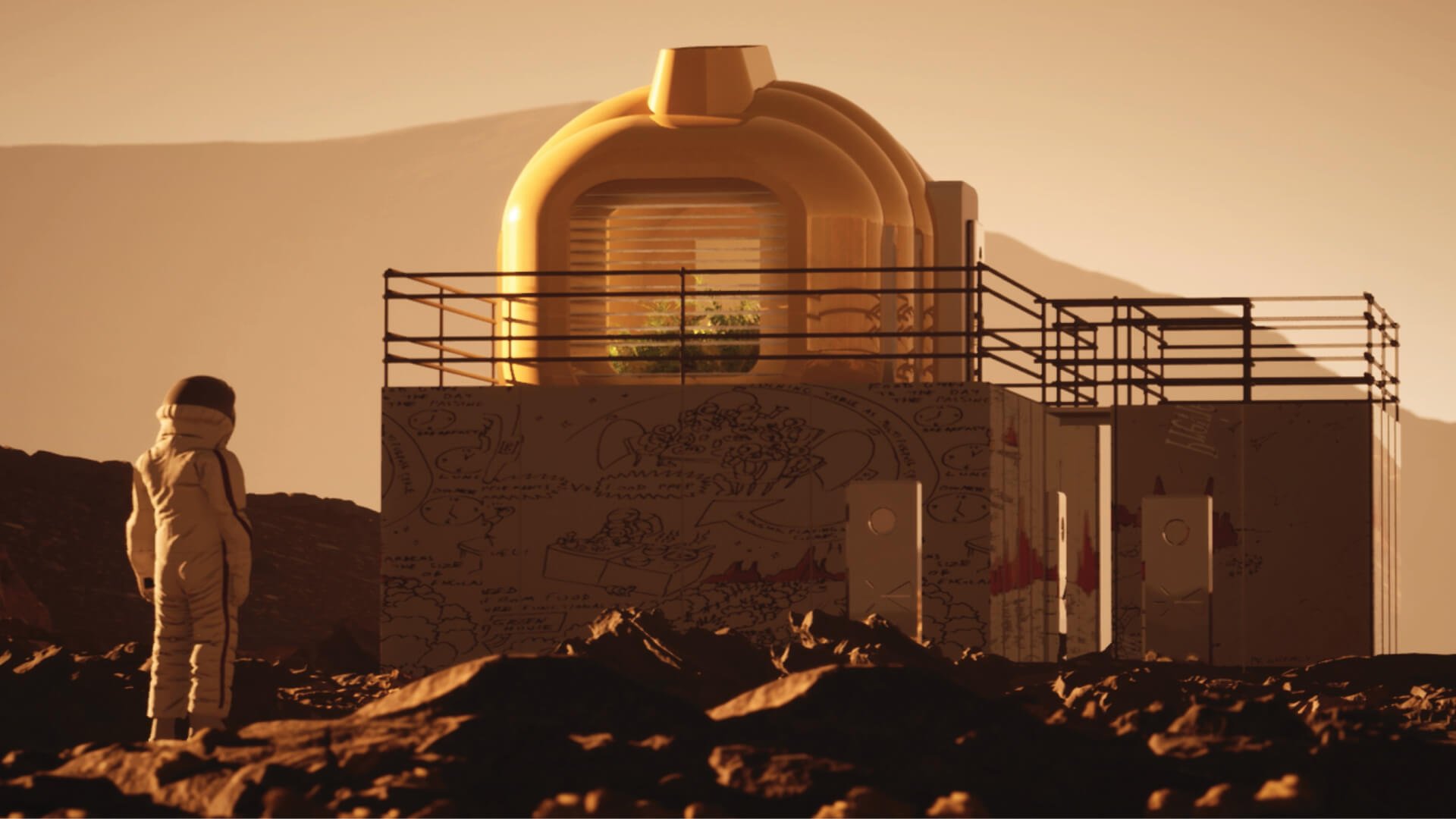BUILDING A
MARTIAN HOUSE
Bristol, Summer 2023
Creating a multi-purpose mobile App for the Martian House
Martian House App project
Matt Austin, Aravind Satheesh, Julian Parsons, Dominic O’Neill
Introduction
Artists Ella Good and Nicki Kent have created a Martian House that currently sits in M Shed Square, Bristol, co-designed with architects, scientists and the general public. It is a prototype of a house that could be lived in on Mars. It is also a public artwork and a research centre. The interiors are being made with a group of Bristolians re-imagining what the objects of everyday living in a zero-waste environment might look like, filling the inside of the house with inventions, ideas and colour.
This article discusses how, as a part of the Interiors team, a multi-purpose mobile application was quickly created to enhance the Martian House experience for visitors. This is probably not what a community on Mars would actually need to build for themselves to support their lives on Mars, but the process followed could be similar.
Background
The Interiors team had a series of face to face meetings and brainstorming discussions, to decide how the inside of the house should be developed, based on how they imagined people would live in that Martian environment. As part of these discussions there were ideas to simulate an environmental monitor (Matt and Julian) to show the dependencies on factors such as oxygen supply, water supply, power consumption/ reserves, etc.
During these investigations it was discovered that NASA published interfaces to allow access to cameras on the Mars Rover vehicle, and also published weather reports from Mars. The team felt that it would aid understanding of what it would be like to live in the house on Mars, by providing the context of the environmental constraints, to see real images from the surface of Mars, and to see the real weather conditions experienced on Mars. On this basis it was decided to try and develop a mobile application that could simulate the environmental monitor and present Mars images and Mars weather. This would create an interactive experience for visitor’s which would lead them to a better understanding of the design decisions being taken across the broader Martian House project.
The Process
It was a very informal but very collaborative process and initial ideas were sketched on paper or mocked up in other tools. For instance, Matt used Power BI for the environmental monitor and Aravind used paper to sketch his ideas. Julian discussed the overall layout in verbal discussions with Dominic and provided links to the NASA programming interfaces, that provided the Mars Rover photographs and Mars weather data.
Initial prototype ideas:
The App team communicated via email, face to face discussion (group meetings and one to one), and video calls. An early prototype was presented to the whole team at the weekly meetup’s on Saturdays, and the feedback was discussed and collated with those present.
The prototype application was drafted using a creative tool (SnapFlo from Cotham Technologies), and assistance was provided by Dominic O’Neill to support the realization of the team’s design.
Incorporation of Feedback
One of the main areas of feedback was to incorporate Earth Sounds into the application. This came about in a collaborative way as one team member (Aravind) was experimenting with Earth sounds (Birdsong, Waves, Wind, etc.) in the house and it was suggested that this could be incorporated into the App. This would allow visitors to select Earth sounds which could remind occupants of the house of their times on Earth, and provide an environment for relaxation and meditation.
Aravind further proposed to incorporate the ability to see the weather conditions on Earth from a specified location on Earth. The idea was for people to feel connected to their home city, or place of birth, as well as hear sounds from Earth that would remind them of home and/or provide some ambient sounds for reminiscing or just relaxing. These were topics that were discussed amongst the wider team, at earlier group brainstorming sessions, and then filtered through during the App build process. Dominic then took this a stage further by incorporating images as well as weather reports.
Martian Context
Due to the ability of the SnapFlo tool to make changes to the App in real time, it was possible to implement these changes very quickly and to re-present the prototype to the team for feedback. This in turn generated ideas for further changes and enhancements, which may be incorporated into later releases of the application. At no stage was there any discussion about writing software code, or any other steps of a traditional software development process. This ensured that it was a very collaborative process with the majority of the time spent discussing how the App should look, feel and perform. The creators could instantly make the changes and assess the impact without going through a separate team to develop the App.
In a Martian context this could be a very useful process. The participants could agree upon an App that would benefit the wider community, or be a necessity, and could then work together to design how the App should perform. Members of the team could trial ideas until the overall design and implementation is agreed upon by the community.
Conclusion
Overall this process felt very collaborative and embodied a lot of the thinking and ideas that had taken place across multiple meetings of the full interiors team. The App has been realized in the Martian house as a type of control console mounted on the wall of the house. Visitors will be able to interact with the App to understand the actual Martian weather and see detailed images of the Martian landscape. They can understand the essential factors that would have to be managed on a daily basis and can experiment with different Earth sounds and images within the house. We believe this project provides insight into how a Martian community could develop applications that would benefit their community.





